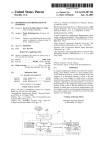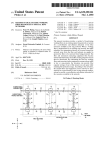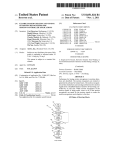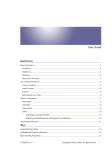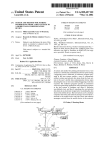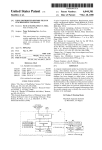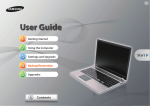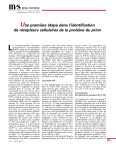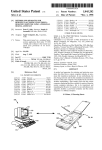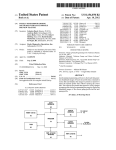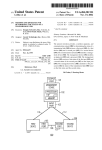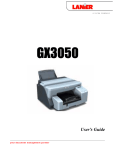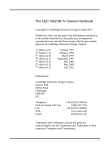Download Method and apparatus for synchronizing a portable computer
Transcript
US006728786B2
(12)
(54)
United States Patent
(10) Patent N0.:
Hawkins et al.
(45) Date of Patent:
METHOD AND APPARATUS FOR
“
COMPUTER SYSTEM WITH A DESKTOP
COMPUTER SYSTEM
5’
Al?eri, “The best book of: Wordperfect 5.0”, Hayden Books
(1988), pp. 153—165 and 429—435.
User Manual For PC—Link for the B.O.S.S. and the PC—link
(Us); J99 Slphen Mountam V1eW> CA
for the B.O.S.S, Traveling Software, Inc. (1989).
(US)’ Llh-Shyng Tzeng’ Sunnyvale’
CA (US); Greg Kucala, Santa Cruz,
CA (Us)
User Manual For Connectivity Pack for the HP 95LX,
Hewlett Packard Company (1991).
Organizer Link II Operation Manual, Sharp Electronics
Corporation, N0 Date.
(73) Assignee: PalmSource, Inc., Sunnyvale, CA (US)
_
_ _
Cobb et al., Paradox 3.5 Handbook 3.Sup.rd Edltlon
Bantam (1991), pp. 803—816.
(75) Inventors: Je?'rey C. Hawkins, Redwood City, CA
(Us); Mont?’ Boyera Sarat9ga>_CA
*
Apr. 27, 2004
OTHER PUBLICATIONS
SYNCHRONIZING A PORTABLE
_
_
( ) Nonce'
US 6,728,786 B2
_
_
_
“Open
Sub]eCt_tO any dlsclalmeri the term of thls
patent is extended or adJusted under 35
U‘SC' 154(k)) by 0 days‘
Network
Computing—Technical
Overview”,
Sun
Technical Report, Sun Microsystems, Inc. pp. 1—32 (1987).
“
.
.
.
,,
.
Automatically Synchromzed ObJects , Research DISClO
sure #29261, p. 614 (Aug. 1988). No Copy Available.
(21) Appl' NO‘: 09/965’243
(List continued on neXt page.)
(22) Filed:
Sep. 26, 2001
(65)
Pnor Pubhcatlon Data
_
_
_
Primary Examiner—Moustafa M. Meky
(74) Attorney, Agent, or Firm—Marcel K. Bingham;
US 2002/0073139 A1 Jun, 13, 2002
Hickman Palermo Truong & Becker LLP
Related US. Application Data
(57)
ABSTRACT
(63) Continuation of application No. 09/318,404, ?led on May
A tightly integratézd Palmtop Computer System and personal
25, 1999, now Pat. No. 6,330,618, which is a continuation
of application No. 08/792,166, ?led on Jan. 30, 1997, now
Pat- N0~ 6,006,274
Int. Cl.7 .............................................. .. G06F 13/00
Computer System 15 dlsclosed The Palmtop Computer System
and personal computer system synchronize with each other
to share information. The synchronization software recog
niZes different Synchronization environments including:
(51)
(52) U S C]
.l l
709/248, 709/201, 709/218
l """"""" "
’
’
(58) Fleld 0f Sea2c0h9"272%9€gg’
’
’
’
’
(56)
’ _
palmtop Computer system with multiple personal computer
’
’
707/201 202 104 710/100
’
’
’
References Cited
systems; synchronizing a palmtop computer system with a
remote personal computer system across a network using a
local personal computer system; and remotely synchroniz
U.S. PATENT DOCUMENTS
4,432,057 A
4,807,182 A
4,866,611 A
synchronizing multiple palmtop computer systems with a
single personal computer system; synchronizing a single
2/1984 Daniell et al. ............ .. 364/300
2/1989 Queen ............ ..
364/900
9/1989 Cree et al. ................ .. 364/300
ing with a personal computer system across a telephone line.
The synchronization software handles each different syn
chronization environment appropriately with minimal user
interaction.
57 Claims, 10 Drawing Sheets
(List continued on neXt page.)
410
E
423
Portable
Computer
Hul Sync
427
Program
Hot Sync
Manager
Orad‘e
Senal Line
TOP/l P
Stack
1
450
Hot Sync
Database
$60
Hot Sync
Manager
Senal Line
TCP/l P
Stack
US 6,728,786 B2
Page 2
US. PATENT DOCUMENTS
4,875,159 A
10/1989 Cary 9191- ---------------- -- 364/200
5,598,536 A
1/1997 Slaughter, III et al.
5,630,081 A
5,640,566 A
5/1997 Rybicki et al. ........... .. 395/159
6/1997 v16161 6161. .............. .. 395/610
49566809 A
9/1990 George 9191-
364/900
5,666,530 A
9/1997 (316111 6161.
5,001,628 A
3/1991 Johnson @191-
364/200
5,666,553 A
9/1997 CIOZICI ..... ..
5,065,360
A
11/1991
Kelly
...........
. . . .. 364/900
8/1992 Webster, III --
395/157
5,696,702 A
5,187,787 A
52106868 A
2/1993 Skew 9191- -5/1993 Shimada 9t 91- -
395/600
395/600
5,701,423 A
5,710,922 A
52376678 A
8/1993 Kuechler e191-
395/600
5,729,452 A
3/1998 81111111 6161.
. 364/999.999
5,251,291 A
10/1993 Malcolm ---- --
395/146
5,900,875 A
5/1999
..... .. 345/349
52616045 A
52616094 A
11/1993 5911117 9191- 11/1993 Everson e191-
395/161
395/600
5,953,507 A
5,974,238 A
5,272,628 A
12/1993 K955 ---------- --
53016313 A
5,315,709 A
4/1994 Terada 9191
5/1994 Alston, Jr. et al.
5,327,555 A
7/1994 Anderson ......... ..
395/600
5,333,252 A
7/1994 Brewer, III et al. .
395/148
5339392 A
8/1994 Risberg et a1_ __
5,339,434 A
8/1994
5,355,476 A
53796057 A
Zachery - - - - -
364/419
2/1994
Rusis
........
10/1994 Fukumura
1/1995 (31911811 ct a1~
- - - -- 395/500
395/600
*
*
6,006,274 A
6,205,448 B1
Boothby
______ __
395/619
. 364/999.999
12/1997 (3162161 ........ ..
1/1998 A116y 6161.
395/335
..... .. 395/617
1161161116161.
9/1999 c1161111g 6161.
10/1999 (311666, Jr. ....... ..
12/1999
3/2001
6,330,618 B1 * 12/2001
..... .. 709/208
.. 395/200.78
1161611116 6161. .......... .. 709/248
Kruglikov 6161.
707/200
1161611116 6161. .......... .. 709/248
395/700
OTHER PUBLICATIONS
“FRX Extends Reporting Power Of Platinum Series: (IBM
. . . .. 395/700
Desktop Software’s Line of Accounting Software)” Doug
395/600
345/173
Dayton, PC Week, v. 8, No. 5, p. 29(2), Feb. 1991.
Zahn, et al., Network Computer Architecture, pp. 1—11,
19—31, 87—115, 117—133, 187—199, 201—209 (1990).
A
A
A
A
A
10/1995
12/1995
5/1996
7/1996
8/1996
Thompson 6161.
Dauerer et a1_ __
FridNielsen 61 a1_
King et al. .... ..
Robinson et al.
5,574,859 A
11/1996
Yeh ............... ..
5,592,669 A
11/1997
12/1997 8161111161 6161.
395/600
2
5,463,772
5,475,833
5,519,606
5,537,592
5,544,356
A
395/617
. 395/803
5,142,619 A
52836887 A
5,684,990
709/216
395/600
395/600
364/401
.. 395/600
395/600
ImeHlLmk Brochllr‘? (1990)"_ _
_
_
“Inoglcal Connect1v1ty: Applications, Requlrernents, Archi
tecture, and Research Agenda,” Stuart Madnick & Y. Rich
ard Wang, MIT, System Sciences, 1991, Hawaii Int’l, vol. 1,
IEEE, Jun. 1991.
. 395/999.999
1/1997 Robinson et al. ......... .. 395/600
* cited by examiner
U.S. Patent
Apr. 27, 2004
Sheet 1 0f 10
US 6,728,786 B2
140
@120
0”»125
TCP/IP
160
150
FIGURE 1
U.S. Patent
Apr. 27, 2004
Sheet 2 0f 10
Hotsync Manager
m
Monitors Serial Port
US 6,728,786 B2
210
ll
Portable Computer
Requests Synchronization N215
l
Hotsync Manager Requests
identification information
From Portable Computer
l
Portable Sends Empty
/\/230
Identification Fields
l s There
Back-up
235
Information
in PC?
Ask User If
Back-up is Desired
/\/Z4O
User
245
Requests
Restore Portable Computer
Yes
Using Back-up
Back-up
Request Name From User /\_/260
V
2650
2702
Store Portable Name
Obtain Net Address
l
of PC if Available
and Preferred PC
Address on Portable
FIGURE 2
2752
Give Unique
= Sync Token
to Portable
U.S. Patent
Apr. 27, 2004
Sheet 3 0f 10
US 6,728,786 B2
Are
TCP/IP Services
Available?
Obtain Host Name of
PC if Possible
K’Q’ZO
V
Obtain IP Address of
PC if Possible
N330
V
Obtain Subnet Mask of
PC if Possible
FIGURE 3
N340
U.S. Patent
Apr. 27, 2004
Sheet 4 0f 10
US 6,728,786 B2
420
410
8
E 423
Portable
Computer
H at Sync
Hot Sync
Database
Program
‘
/\,
415
427
421
r
Hot Sync _
Cradle
8
(J
_
Manager
TCP/lP
Stack
A
1
Serial Line
‘
l
_
I
Z
450
"Preferred" PC
Hot Sync /\,463
Database
467
461
8
l
Hot Sync
Cradle
Manager
V
‘
V
TCP/lP
Stack
1
Serial Line
FIGURE 4
$60
A
V
U.S. Patent
Apr. 27, 2004
Sheet 5 0f 10
US 6,728,786 B2
Portable Sends
Sync Request
PC Requests Information @507
l
Portable Sends
Portable System Name,
"Preferred" PC IP
Address, and
Last Sync Token
/\/509
515
this the
510
Last PC
I Synced
With?
To Fig. 55
FIGURE 5A
8
Perform Fast Sync
Using Flags
U.S. Patent
Apr. 27, 2004
Sheet 6 6f 10
US 6,728,786 B2
From Fig. 5A
TCP/IP
Does an
Identification
525
A
t
Information Available
PCOUH
for Both this PC
and "Preferred"
for this Portable
Exist?
Compare PC Hostname
and/or lP Number with
"Preferred" PC Hostname
and/or IP number
530
8
545
,
Thilssthe
"Preferred"
Perform Slow Sync
Usling Las'rSync
PC?
nformatlon
(C)
(d)
V
To Fig. 50
From Fig. 5C
FIGURE 58
To Fig. 56
U.S. Patent
Apr. 27, 2004
Sheet 7 0f 10
From Fig. 5B
US 6,728,786 B2
To Fig. 58
From Fig. 5B
/
A (0)
550
Are
TCP/IP Services
Available?
555 w
Look for "Preferred" PC
using TCP/lP
560
Does an
Can
"Preferred" PC
Account
for this Portable
be Found?
Exist?
Net Sync Using
570 w
580\
Ask User if a New
TCP/IP Services
Account Should be
On Desk Top PC
Created for This PC
FIGURE 5C
=
E1)
U.S. Patent
Apr. 27, 2004
Sheet 8 0f 10
US 6,728,786 B2
660
p_C
663
Hot Sync
Database
661
7
Cradle
k
f
Hot Sync
669
Manager
8
A
Sena! Llne
Modem
A
PSTN
/_\_,
610
‘V
Hot Sync
Program
8
615
FIGURE 6A
‘
'
Modem
630
U.S. Patent
Apr. 27, 2004
Sheet 9 0f 10
US 6,728,786 B2
@615
Hot Sync
640
‘
8
"
617
TCP/IP
643
A
610
(J
r
619
PPP
SLIP/PPP
Process
A
A
V
Modem
~
Modem
630
641
1
8
650
"Preferred" PC
Hot Sync @663
Database
1
661
667
r
8
Hot Sync _
Cradle
Manager
TCP/IP
Stack
A
Serial Line
FIGURE 6B
Q60
TCP/IP LAN;
U.S. Patent
Apr. 27, 2004
Sheet 10 0f 10
US 6,728,786 B2
[715
HOTSYNC
A
740
w [-717
[J
TCP/IP
[743
“
{-719
,
"
PPP
SLlP/PPP
PROCESS
JV
v
710
/
MODE
M
:
:
/
,
INTERNET
‘
780
MODEM
FIREWALL/GATEWAY
/
730
741
PROXY
PROXY
PROXY
/
/
/
791
792
793
A
K750 INTERNALLAN
HOTSYNC
763
DAT?BASE 761
‘'
CRADLE
767
/J
v r}
HOTSYNC
A
L
MANAGER
‘
'TCP/[P STACK
“
SERIALLINE
FIG. 7
US 6,728,786 B2
1
2
METHOD AND APPARATUS FOR
SYNCHRONIZING A PORTABLE
COMPUTER SYSTEM WITH A DESKTOP
COMPUTER SYSTEM
Different synchronization environments include: synchro
nizing multiple palmtop computer systems With a single
personal computer system; synchronizing a single palmtop
computer system With multiple personal computer systems;
synchronizing a palmtop computer system With a remote
personal computer system across a netWork using a local
This application is a continuation of application Ser. No.
09/318,404, ?led on May 25, 1999, now US. Pat. No.
6,330,618, Which is a continuation of application Ser. No.
08/792,166, ?led Jan. 30, 1997, now US. Pat. No. 6,006,
274.
personal computer system; and remotely synchronizing With
a personal computer system across a telephone line. The
10
softWare architecture of the present invention recognizes
each of these different synchronization environments and
performs the synchronization of information appropriately.
FIELD OF THE INVENTION
BRIEF DESCRIPTION OF THE DRAWINGS
The present invention relates to the ?eld of portable
computers systems. Speci?cally, the present invention dis
closes a systems for synchronizing a portable computer
system With a desktop computer system.
15
BACKGROUND OF THE INVENTION
Personal computer systems have become common tools in
modem society. To organize their lives, many personal
20
computer users use Personal Information Management
portable computer system acquires the identi?cation infor
mation required to properly perform synchronizations in
25
computer system to access the information.
To remedy this limitation, many palmtop computer orga
nizers have been introduced. A palmtop computer organizer
is a computer that is small enough to be held in the hand of
a user and runs Personal Information Management (PIM)
applications such as an address book, a daily organizer, and
electronic notepads. Examples of palmtop computer orga
nizers include the Sharp® Zaurus, the Apple® NeWton®,
and the Tandy® ZoomerTM.
various environments.
FIG. 3 illustrates a How diagram that describes hoW to
obtain an address for a preferred synchronization personal
computer system.
FIG. 4 illustrates a block diagram that depicts the softWare
30
architecture for synchronizing a portable computer through
a ?rst personal computer to a second personal computer
using a netWork.
35
HoWever, the palmtop organizers also suffer from a num
ber of limitations. Entering information into a palmtop
organizer is usually performed by typing on a keyboard that
is too small for normal typing, or by Writing onto a digitizer
With a stylus and relying on handWriting recognition soft
synchronizing With the portable computer systems.
FIG. 2 illustrates a How diagram that describes hoW a
(PIM) applications such as an address book, a daily
organizer, and a To-Do list application on their personal
computers. Although such Personal Information Manage
ment applications have proven useful, their utility is limited
by the fact that the person must be sitting their personal
The objects, features, and advantages of the present
invention Will be apparent from the folloWing detailed
description of the preferred embodiment of the invention
With references to the folloWing draWings.
FIG. 1 illustrates a tWo portable computer systems and
tWo personal computer systems equipped With cradles for
40
FIGS. 5a, 5b, and 5c illustrate a floW diagram that depicts
the beginning of the synchronization betWeen a portable
computer system and a personal computer system.
FIG. 6a illustrates a block diagram that depicts the
softWare architecture for synchronizing a portable computer
With a personal computer using tWo modems and the Public
SWitched Telephone NetWork (PSTN).
Ware. Backing up the information on a palmtop organizer is
FIG. 6b illustrates a block diagram that depicts the
softWare architecture for synchronizing a portable computer
often a difficult and time consuming task requiring special
cables and softWare. Printing the information stored Within
With a personal computer using a PPP connection betWeen
the portable computer system and a netWork coupled to the
a palmtop organizer system is dif?cult since special printer
45
cables must connect the palmtop organizer to a printer.
FIG. 7 illustrates a block diagram that depicts the softWare
architecture for synchronizing a portable computer With a
personal computer using a PPP connection betWeen the
portable computer system and an Internet Service Provider
SUMMARY AND OBJECTS OF THE
INVENTION
It is therefore an object of the present invention to provide
an easy to use palmtop computer system that is Well inte
50
grated With a personal computer system. By tightly integrat
ing the palmtop computer system With a personal computer
Methods and apparatus for implementing a palmtop com
55
to the computer system, the present invention teaches syn
chronization of information on the palmtop computer system
and the personal computer system.
To integrate the palmtop computer system With a personal
computer system in a user friendly manner, the palmtop
computer system must be able to handle many different
tem should handle the different synchronization environ
ments in a manner that requires very little user interaction.
Thus, the palmtop computer system and the personal com
puter system that is Well integrated With a personal computer
system is disclosed. In the folloWing description, for pur
poses of explanation, speci?c nomenclature is set forth to
provide a thorough understanding of the present invention.
HoWever, it Will be apparent to one skilled in the art that
60
synchronization environments. The palmtop computer sys
puter system must automatically recognized the synchroni
zation environment and perform the synchronization.
(ISP).
DETAILED DESCRIPTION
system, an already eXisting computer infrastructure can
easily be used by the palmtop computer system. To integrate
personal computer.
65
these speci?c details are not required to practice the present
invention. In other instances, Well-knoWn circuits and
devices are shoWn in block diagram form to avoid obscuring
the present invention.
Basic Synchronization
FIG. 1 illustrates a portable computer system 130. The
portable computer system 130 may eXecute a number of
US 6,728,786 B2
3
4
different computer programs. However, the most common
tem 140 can be placed into the same cradle 120. When the
applications on the portable computer system 130 Will
synchroniZation button is pushed, the synchroniZation pro
consist of a suite of Personal Information Management
(PIM) applications such as an addressbook, a daily
organizer, a To-Do list, and a memo pad. Most people that
use a portable computer system 130, also have a personal
computer system that has the same applications. It Would
therefore be desirable to synchroniZe information betWeen
cess begins.
In order to properly back-up the second portable computer
system 140, the personal computer system 110 needs to
recogniZe that the second portable computer system 140 is
different from the ?rst portable computer system 130 such
that the data from the ?rst portable computer system 130 is
not destroyed. To accomplish this goal, each portable com
the portable computer system 130 and the personal computer
system.
puter system is assigned a name. Typically, the name of the
Also illustrated in FIG. 1 is a desktop personal computer
system 110. Coupled to the serial port 113 of the desktop
personal computer system 110 is a cradle 120. The cradle is
portable computer system Will be the same name as the user
of the portable computer system. The name of the portable
used to provide a serial communication link betWeen the
portable computer system 130 and the personal computer
15
system 110. Speci?cally, the serial communication lines
inserted into the cradle and synchroniZed, the personal
computer system 110 Will recogniZe that a different portable
computer system is being synchroniZe such that a different
database Will be used. The ?rst time the second portable
computer system 140 is synchroniZed, the personal com
from the serial port 113 are eXtended and terminate at a serial
connector 127 on the cradle 120. A matching serial connec
tor (not shoWn) on the portable computer system 130
connects the portable computer system 130 to the personal
computer system 110.
To synchroniZe the information betWeen the portable
puter Will ask the user if a neW account should be created on
the personal computer system 110 for storing information
computer system 130 and the personal computer system 110,
a user drops the portable computer system 130 into the
cradle 120 and presses a synchroniZation button 125. The
synchroniZation button 125 causes a synchroniZation pro
gram on the portable computer system 130 to eXecute. The
computer system is assigned When the portable computer
system is ?rst synchroniZed.
Then, When the second portable computer 140 system is
25
from the second portable computer 140. Thus, a second
portable computer can be synchroniZed on a single personal
computer.
SynchroniZation With a Second Desktop Computer
System
synchroniZation program on the portable computer system
130 Wakes up a peer synchroniZation program on the per
sonal computer system 110. The synchroniZation program
on the portable computer system 130 and the peer synchro
niZation program on the personal computer system 110
The user of a portable computer system may Work With
more than one personal computer system. For eXample,
many White collar Workers that use a personal computer
system at an of?ce often have a second personal computer
perform the necessary operations to synchroniZe informa
system at home. The second personal computer system
tion stored on the tWo computer systems. The architecture of
alloWs the Worker to Work at night, Work on Weekends, or
the synchroniZation process is described in the US. patent
application entitled “EXtendible Method and Apparatus for
telecommute by Working at home. It Would be desirable to
alloW such a user to synchroniZe With both the personal
computer at the office and the second personal computer
system at home.
Referring to FIG. 1, a second personal computer system
150 With a second cradle 160 is illustrated. If the portable
computer system 130 is placed into the second cradle 160
and the synchroniZation button 165 is pressed, then the
Synchronizing Multiple Files On TWo Different Computer
Systems” With Ser. No. 08/542,055, ?led on Oct. 13, 1995,
now US. Pat. 5,884,323.
To ef?ciently synchroniZe the information betWeen the
tWo computer systems, each system maintains a set of status
?ags for each of the data records. The status ?ags on each
data record identify if the record is neW, modi?ed, or
deleted. Thus, When a record on the portable computer
portable computer system 130 Will attempt to synchroniZe
With the second personal computer system 150.
system 130 or the personal computer system 110 is created,
As described in a previous section, the data records on the
modi?ed, or deleted, the status ?ags for that record are set
to neW, modi?ed, or deleted respectively. The status ?ags on
portable computer system 130 each have ?ags that speci?ed
the data records greatly simplify the synchroniZation process
synchroniZation. HoWever, these ?ags are only relevant to
if the record is neW, modi?ed, or deleted since the last
since only the neW, modi?ed, or deleted records on each
the particular personal computer system that the portable
computer system 130 last synchroniZed With. If the portable
computer system need to be shared With the other computer
system. After each synchroniZation, all the data record status
?ags are cleared since the tWo systems have identical
computer system 130 has been synchroniZed With a ?rst
personal computer system 110 and then the user later
databases after the synchroniZation point.
SynchroniZation of a Second Portable Computer
55
status ?ags on the data records Will only relate to the ?rst
System
personal computer system 110.
As described in the previous section, a personal computer
Thus, an interesting problem is created When a portable
computer system is synchroniZed With a ?rst personal com
puter system, used, and then later synchroniZed With a
system can easily be equipped With a cradle 120 that alloWs
a portable computer system 130 to synchroniZe With the
personal computer system 110. In this manner, the informa
tion on the portable computer system 130 can be backed-up
on the personal computer system 110.
second personal computer system. To handle the problem,
the synchroniZation program on each personal computer
system stores a copy of the reconciled database after each
Each personal computer system usually has ample
resources for backing-up several portable computer systems.
To back-up another portable computer system, such as
portable computer 140, the second portable computer sys
attempts to synchroniZe the portable computer system 130
With the second personal computer system 150, then the
65
synchroniZation. The stored database copy is not modi?ed.
Then, When a synchroniZation must be performed Wherein
the neW, modi?ed, deleted record ?ags are not available,
then the entire contents of the portable computer database is
US 6,728,786 B2
5
6
read and compared With the stored database. This compari
computer system into the cradle 120 of the nearby personal
computer 110 and presses the synchronization button 125.
son Will yield a set of records that have been created (new),
modi?ed, or deleted since the last synchronization. These
The synchronization process then commences.
neW, modi?ed, and delete records can then be used to
Using the identi?er that uniquely addresses the “pre
ferred” computer, the synchronization softWare in personal
computer 110 attempts to reach the preferred computer
synchronize With the personal computer’s current database.
A detailed description of this technique can be found in the
US. patent application entitled “Method and Apparatus for
Synchronizing Information on TWo Different Computer Sys
across the netWork 180. If the synchronization softWare in
personal computer 110 can reach the preferred personal
computer 150 through the netWork 180, then the synchro
tems” With Ser. No. 08/544,927, ?led on Oct. 18, 1995, now
US. Pat. No. 5,727,202. In this document, a synchronization
nization softWare in personal computer 110 simply acts as a
that requires the copy of the database from the previous
pass-through and alloWs the synchronization softWare in
personal computer 150 to perform the synchronization. This
synchronization is knoWn as a “sloW sync.”
Before the problem of multiple synchronization hosts for
a single portable computer can be solved, the problem ?rst
must be detected. To detect the problem of synchronizing
type of synchronization is referred to as a “net synchroni
zation.” If personal computer 110 can not reach the preferred
15
With multiple personal computers, the portable computer
user may still synchronize With the local personal computer
110.
creates a unique synchronization token after each synchro
nization. The synchronization token is stored by both the
Obtaining Synchronization Information
portable computer system and the personal computer sys
tem. Later, When a synchronization is attempted, the tWo
As described in the previous sections the present inven
systems compare synchronization tokens. If the synchroni
zation tokens do not match, then the portable computer
tion uses three pieces of identi?cation information in order
to synchronize properly: a portable computer user name; a
system’s last synchronization Was With a different personal
computer system. In such situations, the reconciled database
from the previous synchronization With this computer is
fetched to perform the current synchronization.
personal computer 150 through the netWork 180, then the
net address of the personal computer; and a unique synchro
25
nization token. These three pieces of information are ini
tialized When the portable computer system is ?rst synchro
nized. The user name for the portable computer Will remain
static unless the user speci?cally requests a change. The net
address of the personal computer may change due to a
SYNCHRONIZATION ACROSS A NETWORK
Personal computer systems are often coupled together
into computer netWorks. When personal computer systems
request by the user or an automatic update by the synchro
nization softWare. A neW unique synchronization token is
are coupled together into a netWork, each computer system
created every time the portable computer system is synchro
can its share resources With the other computer systems
nized With a personal computer system.
coupled to the netWork. Similarly, each computer system can
access the shared resources available from the other com
puter systems coupled to the netWork.
When a personal computer that is used to synchronize
portable computers is coupled to a netWork, that netWork
FIG. 2 illustrates a How diagram of an initialization that
35
table computer system is brand neW and has never been
used, or if all the information in the portable computer has
been lost due to malfunction or complete battery discharge.
Referring to FIG. 2 the How diagram starts Where the Hot
infrastructure can be used to route a synchronization to that
“preferred” personal computer. For example, a user of a
portable computer system Will usually have a personal
computer system that is “his” personal computer system.
Sync Manager on the personal computer system is monitor
ing the serial port. (As described in previous sections, the
synchronization may be performed With other communica
The user Will store his personal data such his address lists,
his personal calendar, and his To-Do list on his personal
computer. NeW changes to the address list, calendar, and
occurs during the ?rst synchronization process of a portable
computer system. The initialization occurs When the por
tion means, but in most cases the ?rst synchronization Will
45
To-Do list Will be made to his personal computer. It Would
therefore be desirable to alWays synchronize With his per
sonal computer (a “preferred” computer).
be across a serial line.) Then, at step 215, the portable
computer requests a synchronization. At step 220, the Hot
Sync manager on the personal computer responds to the
synchronization request by sending a request for the iden
ti?cation information on the portable computer system. At
Often, the user of a portable computer system Will not be
near his personal computer system. But if the user is near a
step 230, the portable computer system sends empty iden
personal computer that is coupled to his personal computer
ti?cation ?elds back to the Hot Sync Manager program on
the personal computer since the portable computer system is
through a netWork, the user can synchronize With his per
sonal computer using the netWork as a communication
medium. To perform this synchronization across the
netWork, the portable computer system must store an iden
ti?er that can be used to uniquely address the “preferred”
personal computer across the netWork.
55
portable computer system is indicating that it is brand neW
or it has lost its information because of failure. Thus, the Hot
An eXample can be provided by referring again to FIG. 1.
Sync Manager on the personal computer system ?rst deter
mines if there is any portable computer system back-up
information on the personal computer at step 235. If back-up
In FIG. 1, tWo personal computers 110 and 150 are illus
trated. The tWo personal computers 110 and 150 are coupled
together using a computer netWork 180. In one embodiment,
the computer netWork 180 uses the TCP/IP suite of proto
cols. Personal computer 150 Will be designated as the user’s
information for a portable computer system exists on the
personal computer, then at step 240 the Hot Sync Manager
asks the user if he Wishes to restore the portable computer
oWn personal computer (the “preferred” computer). If the
user of portable computer system 130 is near personal
computer 110 and Wishes to synchronize With his personal
computer system 150, the user simply drops his portable
being used for the ?rst time or has lost all of its information.
Since the portable computer system has not sent any
identi?cation information to the Hot Sync Manager, the
system using the back-up information stored on the personal
65
computer system. If the user requests to restore the portable
computer from the back-up information, the Hot Sync
Manager proceeds to step 250 Where the portable computer
US 6,728,786 B2
7
8
system is restored using the back-up copy of information.
Otherwise the system proceeds to step 260 Where the
synchroniZe either With the local personal computer 420 or
the preferred personal computer 460 across the netWork.
process of initializing a neW portable computer system
FIG. 5 illustrates a How diagram that describes an
begins.
embodiment of the synchroniZation process in detail.
Speci?cally, FIG. 5 describes most of the steps performed by
one embodiment of the Hot Sync Manager program 421 to
The ?rst step in initializing a portable computer is to
request a name for the portable computer system as stated in
determine the synchroniZation environment. Initially the
portable computer systems sends a synchroniZation request
step 260. In one embodiment, the portable computer system
simply asks for the name of the intended user. The user name
is assigned to the portable computer system such that the
portable computer system can be identi?ed during future
10
synchroniZations.
local personal computer 420. The personal computer 420
Next, at step 265, the Hot Sync Manager program
recogniZes the synchroniZation request packet and responds
attempts to obtain a netWork address for the personal com
puter system in order to have a “preferred” personal com
puter system. The Hot Sync Manager program attempts to
15
obtain an IP address, a host name, and a SubNet Mask that
Will be used to locate the preferred personal computer
system during future synchroniZation operations across a
netWork. The user name and preferred personal computer
netWork address are stored in the portable computer system
at step 270. Finally a unique synchroniZation token for this
509. At step 510 the synchroniZation program ?rst checks
the last synchroniZation token to determine if this is the same
25
personal computer that the portable computer last synchro
niZed With. If this is the same personal computer that the
portable computer last synchroniZed With, then the Hot Sync
Program immediately performs a fast synchroniZation at
step 515.
If this is not the personal computer that the portable
computer most recently synchroniZed With then the synchro
niZation manager program proceeds to step 525 Where it
personal computer. First at step 310 the Hot Sync Manager
Program determines if the personal computer has TCP/IP
services available. If the personal computer does not have
TCP/IP protocol services then the Hot Sync Manager Pro
gram simply moves to the next step of the synchroniZation
initialiZation. In an alternate embodiment, the Hot Sync
program retrieves a host name for the personal computer
by sending a request for additional information from the
portable computer system 410 at step 507
In response to the request for additional information, the
portable computer 410 sends the three items of identi?cation
information as previously described. Speci?cally, the por
table computer system 410 sends the personal computer
system 420 the portable system’s name, a netWork address
of the preferred personal computer, and the synchroniZation
token received during the previous synchroniZation at step
synchroniZation session is given to the portable computer
system at step 275. The unique synchroniZation token Will
be used next time the portable is synchroniZed to determine
if it is being synchroniZed on the same computer system that
it Was last synchroniZed With.
FIG. 3 illustrates hoW the Hot Sync Manager Program
obtains the netWork address information for the preferred
at step 505. In the case Where the portable computer 410 is
synchroniZing through a cradle as illustrated in FIG. 4, the
synchroniZation request is carried across the serial line to the
35
name from a WindoWs registry. The host name from the
determines if netWork address information is available for
both the personal computer 420 on Which the Hot Sync
Program is running and the “preferred” personal computer
requested by the portable computer system.
registry is then later used to obtain the preferred personal
If netWork address information is not available for both
computer address for synchroniZation operations across a
netWork.
the current personal computer and the desired personal
computer, then the Hot Sync Manager proceeds to step 527
If the personal computer is running TCP/IP protocol, then
Where it may attempt to do some type of local synchroni
Zation. At step 527, the Hot Sync manager determines if an
account for this portable computer exists on this personal
computer. If an account exists on this personal computer for
the Hot Sync Manager proceeds to step 320 Where the Hot
Sync Manager obtains a host name. The host name may later
be used With a Domain name service (DNS) in order to
obtain an IP address for the preferred personal computer.
After obtaining a host name then the Hot Sync Manager
45
proceeds to step 330 Where the Hot Sync Manager deter
mines if the personal computer has been assigned an Internet
Protocol (IP) address. If the personal computer has been
the user is asked if a neW account should be created at step
580.
assigned a IP address then that IP address is stored for future
use. Finally, the Hot Sync Manager proceeds to step 340 and
If at step 525, the Hot Sync Manager determines that the
attempts to obtain a SubNet Mask.
netWork address information is available for both the current
personal computer and the portable’s preferred personal
The SynchroniZation Process
Once a portable computer system has been initialiZed With
the proper information, the portable computer system can be
the portable then the Hot Sync Manager proceeds to step 530
Where a sloW synchroniZation is performed using the last
synchroniZation information available for the portable com
puter system. If the account for this portable does not exist,
computer, then the synchroniZation process proceeds to step
55
synchroniZed With a main desktop personal computer system
540. At step 540 the netWork address of the local personal
computer is compared With the netWork address information
of the preferred personal computer. If the tWo addresses
in a number of different Ways. This section Will describe hoW
match, then this is the preferred personal computer but
the portable computer systems synchroniZes With the per
portable computer Was last synchroniZed With another per
sonal computer system. In such a situation, the Hot Sync
sonal computer system With reference to the block diagram
in FIG. 4 and the How diagram in FIG. 5.
FIG. 4 illustrates a block diagram of a portable computer
system coupled to a personal computer through a serial line
for synchroniZation. The personal computer 420 is also
connected to a local area netWork 450. Other personal 65
computers such as preferred personal computer 460 are also
coupled to the netWork. The portable computer 410 can
Manager performs a sloW synchroniZation using the infor
mation stored from the last synchroniZation With this per
sonal computer at step 530.
If this is not the preferred the personal computer then the
Hot Sync Manager proceeds to step 550 to determine if
TCP/IP services are available on this personal computer. If
TCP/IP services are not available then a synchroniZation
US 6,728,786 B2
10
puter system 660 then a long-distance toll call Will be
across a network cannot be performed. Thus, the Hot Sync
Manager proceeds to step 565 to determine if a local account
for this portable exists. If an account exists, a sloW synchro
required to synchroniZe With the personal computer system
660. Therefore an alternate system of remote synchroniZa
tion is desirable.
niZation is performed using the information stored from the
last synchronization performed With this personal computer.
FIG. 6B illustrates an alternate embodiment of the remote
If no local account exists then the user Will be asked if a neW
synchroniZation system. In the alternate embodiment of FIG.
6B, the Hot Sync Program 615 communicates through a
TCP/IP stack 617 With a Serial Line Internet Protocol (SLIP)
or Point-to-Point Protocol (PPP) client program 619 before
account should be created.
HoWever, if this is not the preferred personal computer
and TCP/IP services are available, then the Hot Sync Man
ager Will look across the netWork for the preferred personal
computer at step 555. If the preferred personal computer can
be contacted across the netWork then the synchronization
10
communicating With modem 630. Thus, by using the TCP/IP
stack 617 and a SLIP or PPP client program 619, the Hot
Sync Program 615 in FIG. 6B attempts a remote synchro
Will be performed With the preferred personal computer
niZation by performing a net synchroniZation across a SLIP
across the netWork. In this situation the local Hot Sync
Program 421 merely acts as a pass-through such that all
or PPP link.
15
To remotely perform a net synchroniZation, the Hot Sync
synchroniZation information passes from the local Hot Sync
Program 421 to the remote Hot Sync Program 461 on the
Program 615 ?rst establishes a SLIP or PPP link With a
server that is coupled to the same netWork as the preferred
preferred personal computer 460. Thus, the remote Hot Sync
personal computer. Thus, the SLIP/PPP softWare using the
Program 461 takes over the SynchroniZation process and
modem 630 to dial and connect to a modem 641 on a remote
access server 640. A SLIP/PPP server process 643 on the
remote access server 640 Will ansWer the call and establish
performs a fast sync or sloW sync as necessary.
Remote SynchroniZation
A person traveling With a portable personal computer
system may Want to synchroniZe With a desktop personal
computer system While on the road. For example, a traveling
executive may Wish to receive calendar updates that have
been placed into his personal computer by an administrative
assistant. One architecture for remotely synchroniZing With
a desktop personal computer is illustrated in FIG. 6A.
Referring to FIG. 6A, the portable computer 610 With its
Hot Sync Program 615 is coupled to a modem 630. The Hot
Sync Program 615 is con?gured such that it can initialiZe the
modem 630 and dial another computer system.
Also illustrated in FIG. 6A is a personal computer system
660 With a Hot Sync Manager Program 661 and a Hot Sync
database 663. To monitor for remote synchroniZations the
a SLIP/PPP session. Once the SLIP/PPP session has been
created the Hot Sync Program 615 can use the netWork
address of the preferred personal computer to access the Hot
25
Sync Manager Program on the preferred personal computer
that is coupled to the TCP/IP Local Area NetWork 650. The
Hot Sync Manager in the preferred personal computer Will
be monitoring the TCP/IP packets for a synchroniZation
request across the TCP/IP LAN. If the Hot Sync Manager
661 on the preferred personal computer gets such a syn
chroniZation request packet, then the Hot Sync Manager 661
begins a synchroniZation With the portable computer system.
35
The TCP/IP based remote synchroniZation system can be
performed using the global Internet. FIG. 7 illustrates an
example of a portable computer system 710 synchroniZing
With a preferred PC 760 across the global Internet 780.
Hot sync Manager can be instructed to listen to a serial line
Speci?cally the Hot Sync Program 715 in the global com
coupled to a modem 669. If a ring signal is detected by the
modem 669 the Hot Sync Manager 661 Will ansWer the call
puter system establishes a PPP or SLIP connection With an
Internet Service Provider (ISP) 740. The SLIP/PPP session
is established betWeen the SLIP/PPP client on the portable
computer system 710 and a SLIP/PPP server 743 at the ISP
and attempt to begin a synchroniZation With a remote
portable computer system 610.
To synchroniZe remotely, the Hot Sync Program 615 on
the portable computer 610 con?gures the modem 630 and
dials the modem 669 coupled to desired personal computer
660. The modem 669 notices the ringing phone and informs
the Hot Sync Manager 661 on the personal computer 660.
The Hot Sync Manager program 661 response by instructing
740. The SLIP/PPP server at the ISP 740 can communicate
across the global Internet to any Internet addressable loca
45
tion. Thus, if the netWork address of the preferred personal
computer 760 is accessible through the global internet 780
then the global computer system 710 can communicate With
the preferred personal computer 716 to perform a remote
synchroniZation.
the modem 669 to ansWer the call. Once the call has been
ansWered, the Hot Sync Manager program 661 listens for a
Many businesses, hoWever, install ?reWall servers or
synchroniZation token. When the Hot Sync Program 615 in
the portable computer system 610 notices the call has been
ansWered by another modem, the Hot Sync Program 615 in
the portable computer system 610 sends a synchroniZation
request token to the computer that ansWered. The Hot Sync
Manager 661 responds to the synchroniZation request token
by requesting the identi?cation information from the por
table computer system 610. The synchroniZation progresses
gateWay servers 790 on their Local Area NetWork as illus
trated in FIG. 7. The ?reWall server acts as a protection
55
pass through a proxy application. In FIG. 7, proxy applica
tions 791, 792 and 793 are used to bridge various commu
nication protocols. Each proxy application ?lters the packets
associated With its respective protocol before alloWing the
as described in the previous sections.
Although the remote synchroniZation system illustrated in
packets to access the internal Local Area NetWork 750. If
such ?reWall system is installed at the corporation of a user
Who Wishes to synchroniZe a portable computer, then a
FIG. 6A is very useful, it suffers from a feW draWbacks. The
synchroniZation system illustrated in FIG. 6A requires a
dedicated telephone line and a modem for the Hot Sync
Manager 661 on the preferred personal computer 660.
Furthermore, the modem 669 is only used to listen for
synchroniZation requests. Additionally, if the user With the
portable computer 610 is far aWay from the personal com
mechanism to protect the internal Local Area NetWork 750
of a company from attacks by unscrupulous Internet users.
One method of protecting the internal Local Area NetWork
is to require any communication With the global Internet to
proxy application for the speci?c synchroniZation protocol
65
may be required.
Although the present invention has been described in
terms of speci?c exemplary embodiments, it Will be appre
US 6,728,786 B2
11
12
ciated that various modi?cations and alterations might be
made by those skilled in the art Without departing from the
spirit and scope of the invention as set forth in the following
claims.
What is claimed is:
10. The computer implemented method of claim 9, further
comprising executing at least a portion of the second set of
synchroniZation instructions.
11. The computer implemented method of claim 9,
Wherein enabling a second set of synchroniZation instruc
1. A computer implemented method for synchronizing
records betWeen computer systems, Wherein the method is
performed on a portable computer and comprises the steps
of:
connecting to a ?rst computer using a local port, Wherein
the ?rst computer is coupled to a second computer
through a netWork;
in response to the second computer executing a ?rst set of
synchronization instructions to synchroniZe a ?rst set of
records on the portable computer:
receiving the ?rst set of records from the second
tions to be executed includes enabling one or more records
to be deleted from the set of existing records.
12. The computer implemented method of claim 9,
10
13. The computer implemented method of claim 9,
Wherein transferring a ?rst set of records includes transfer
ring one or more records for use With an address book
15
application.
14. The computer implemented method of claim 9,
Wherein transferring a ?rst set of records includes transfer
computer through the local port; and
ring one or more records for use With a calendar application.
executing a second set of synchroniZation instructions
for synchroniZing the ?rst set of records With a set of
15. The computer implemented method of claim 9, further
comprising providing an identi?cation of the portable com
puter to the second computer.
existing records that are stored on the portable com
puter.
16. The computer implemented method of claim 15,
Wherein providing an identi?cation of the portable computer
2. The computer implemented method of claim 1, Wherein
executing a second set of synchroniZation instructions
includes providing an identi?cation of a user of the portable
includes deleting one or more records from the set of
existing records.
Wherein enabling a second set of synchroniZation instruc
tions to be executed includes enabling the set of existing
records to be replaced With the ?rst set of records.
25
computer.
17. The computer implemented method of claim 9, further
3. The computer implemented method of claim 1, Wherein
comprising:
executing a second set of synchroniZation instructions
includes replacing the set of existing records With the ?rst set
of records.
recogniZing the ?rst computer as preferred for the por
table computer; and signaling to a user that the second
4. The computer implemented method of claim 1, Wherein
receiving the ?rst set of records through the local port
computer is not preferred.
18. The computer implemented method of claim 9,
includes receiving one or more records for use With an
Wherein the step of transferring a ?rst set of records port is
address book application.
performed in response to the steps of:
recogniZing the ?rst computer as preferred for the por
5. The computer implemented method of claim 1, Wherein
receiving the ?rst set of records through the local port
35
table computer; and causing a signal that informs a user
includes receiving one or more records for use With a
that the second computer is not preferred to be provided
calendar application.
to the user.
19. A computer implemented method for synchroniZing
records betWeen computer systems, the method comprising
6. The computer implemented method of claim 1, further
comprising sending an identi?cation of the portable com
puter to the second computer using the netWork.
7. The computer implemented method of claim 6, Wherein
sending an identi?cation of the portable computer includes
performing the folloWing steps on a ?rst computer:
the ?rst computer connecting to a portable computer using
a netWork connection betWeen the ?rst computer and a
sending the identi?cation that is based on a name of a user
of the portable computer.
8. The computer implemented method of clam 1, further
second computer and a local port betWeen the second
45
comprising:
instructions; and
recogniZing that the ?rst computer is preferred for the
Wherein execution of said ?rst set of instructions by said
portable computer; and indicating to a user that the
?rst computer causes:
said ?rst computer to transfer a ?rst set of records to the
second computer is not preferred prior to performing
the step of receiving the ?rst set of records from the
second computer.
9. A computer implemented method for synchroniZing
records betWeen computer systems, Wherein the method is
performed on a ?rst computer and comprises the steps of:
connecting to a portable computer using a local port;
connecting to a second computer using a netWork;
in response to the second computer executing a ?rst set of
synchroniZation instructions to synchroniZe a ?rst set of
records on the portable computer:
transferring the ?rst set of records sent from the second
computer through the netWork to the portable com
portable computer, and
said portable computer to synchroniZe the ?rst set of
records received from the ?rst computer With a set of
existing records that are stored on the portable com
55
puter.
20. The computer implemented method of claim 19,
Wherein executing a ?rst set of synchroniZation instructions
causes comparing the ?rst set of records to the set of existing
records.
21. The computer implemented method of claim 19,
Wherein executing a ?rst set of synchroniZation instructions
causes one or more records to be deleted from the set of
existing records.
puter using the local port; and
enabling a second set of synchroniZation instructions to
be executed on the portable computer in order to
cause the ?rst set of records to be synchroniZed With
a set of existing records on the portable computer.
computer and the portable computer;
said ?rst computer executing a ?rst set of synchroniZation
22. The computer implemented method of claim 19,
65
Wherein executing a ?rst set of synchroniZation instructions
causes the set of existing records to be replaced With the ?rst
set of records.
US 6,728,786 B2
14
13
23. The computer implemented method of claim 19,
33. The computer readable medium of claim 32, Wherein
instructions for executing a second set of synchronization
Wherein executing a ?rst set of synchronization instructions
causes transferring one or more records for use With an
instructions include instructions for deleting one or more
address book application.
24. The computer implemented method of claim 19,
records from the set of existing records.
34. The computer readable medium of claim 32, Wherein
instructions for executing a second set of synchronization
instructions include instructions for replacing the set of
existing records With the ?rst set of records.
35. The computer readable medium of claim 32, Wherein
instructions for receiving the ?rst set of records through the
Wherein executing a ?rst set of synchronization instructions
causes transferring one or more records for use With a
calendar application.
25. The computer implemented method of claim 19,
Wherein executing a ?rst set of synchronization instructions
is performed in response to recognizing that another com
local port include instructions for receiving one or more
records for use With an address book application.
puter is preferred for the portable computer.
26. The computer implemented method of 19, Wherein
36. The computer readable medium of claim 32, Wherein
instructions for receiving the ?rst set of records through the
executing a ?rst set of synchronization instructions is per
formed in response to the steps of:
recognizing that another computer is preferred for the
15
portable computer; and
local port include instructions for receiving one or more
records for use With a calendar application.
37. The computer readable medium of claim 32, further
comprising instructions for sending an identi?cation of the
portable computer to the second computer using the net
Work.
38. The computer readable medium of claim 37, Wherein
instructions for sending an identi?cation of the portable
computer include instructions for sending the identi?cation
causing a signal that informs a user that the second
computer is not preferred to be provided to the user.
27. A portable computer comprising:
a local port con?gured to locally connect to a ?rst
computer, Wherein the ?rst computer is coupled to a
second computer over a netWork;
a memory that stores a set of records; and
that is based on a name of a user of the portable computer.
a processor con?gured to:
25
39. The computer readable medium of claim 32, further
use the local port to connect to the ?rst computer and
comprising instructions for performing the steps of: recog
communicate With a second computer that is coupled
to the ?rst computer over the netWork;
nizing that the ?rst computer is preferred for the portable
computer; and indicating to a user that the second computer
Wherein in response to the second computer executing
a ?rst set of synchronization instructions to synchro
is not preferred prior to performing
the step of receiving the ?rst set of records from the
second computer.
nize a ?rst set of records on the portable computer,
the processor is con?gured to receive the ?rst set of
40. A portable computer comprising:
records from the second computer through the local
a local port for connecting the portable computer to a ?rst
computer, Wherein the ?rst computer is coupled to a
port, and to execute a second set of synchronization
instructions for synchronizing the ?rst set of records
With the set of existing records.
35
second computer over a netWork;
means for connecting to the ?rst computer using the local
28. The portable computer of claim 27, Wherein the
port;
processor is con?gured to execute the second set of syn
chronization instructions to replace the set of existing
means for receiving the ?rst set of records sent from the
second computer over the netWork to the ?rst computer
records With the ?rst set of records.
29. The portable computer of claim 27 Wherein the
and through the local port to the portable computer; and
processor is con?gured to execute the second set of syn
chronization instructions to delete the set of existing records.
means for executing, in response to the second computer
executing a ?rst set of synchronization instructions to
synchronize the ?rst set of records on the portable
30. The portable computer of claim 27, Wherein the
processor is con?gured to execute an address book 45
application, and Wherein at least some of the ?rst set of
records includes records for use With the address book
application.
puter.
31. The portable computer of claim 27, Wherein the
41. The portable computer of claim 40, Wherein the means
for executing a second set of synchronization instructions
processor is con?gured to execute a calendar application,
and Wherein at least some of the ?rst set of records includes
records for use With the calendar application.
32. A computer readable medium for synchronizing
records betWeen computer systems, the computer readable
medium carrying instructions for performing the steps of:
connecting a portable computer to a ?rst computer using
includes means for deleting one or more records from the set
of existing records.
55
a local port, Wherein the ?rst computer is coupled to a
second computer through a netWork;
in response to the second computer executing a ?rst set of
synchronization instructions to synchronize a ?rst set of
records on the portable computer:
receiving the ?rst set of records from the second
existing records that are stored on the portable com
puter.
42. The portable computer of claim 40, Wherein the means
for executing a second set of synchronization instructions
includes means for replacing the set of existing records With
the ?rst set of records.
43. The portable computer of claim 40, Wherein the means
for receiving the ?rst set of records through the local port
includes means for receiving one or more records for use
With an address book application.
44. The portable computer of claim 40, Wherein the means
for receiving the ?rst set of records through the local port
computer through the local port; and
executing a second set of synchronization instructions
for synchronizing the ?rst set of records With a set of
computer, second set of synchronization instructions
for synchronizing the ?rst set of records With a set of
existing records that are stored on the portable com
includes means for receiving one or more records for use
With a calendar application.
65
45. The portable system of claim 40, further comprising
means for sending an identi?cation of the portable computer
to the second computer using the netWork.
US 6,728,786 B2
15
16
46. The portable computer of claim 45, wherein the means
for sending an identi?cation of the portable computer
more processors, causes the one or more processors to
perform the method recited in claim 21.
includes means for sending the identi?cation that is based on
53. A computer-readable medium carrying one or more
sequences of instructions Which, When executed by one or
a name of a user of the portable computer.
47. The portable computer of claim 40, further compris
more processors, causes the one or more processors to
ing:
perform the method recited in claim 22.
means for recognizing that the ?rst computer is preferred
for the portable computer; and
means for indicating to a user that the second computer is
not preferred prior to performing the step of receiving
54. A computer-readable medium carrying one or more
sequences of instructions Which, When executed by one or
10 more processors, causes the one or more processors to
perform the method recited in claim 23.
the ?rst set of records from the second computer.
48. The computer readable medium of claim 32, Wherein
the computer readable medium resides on the portable
computer.
49. The computer readable medium of claim 32, Wherein
the computer readable medium resides on the ?rst computer.
55. A computer-readable medium carrying one or more
sequences of instructions Which, When executed by one or
more processors, causes the one or more processors to
15
50. A computer-readable medium carrying one or more
sequences of instructions Which, When executed by one or
more processors, causes the one or more processors to
perform the method recited in claim 19.
51. A computer-readable medium carrying one or more
sequences of instructions Which, When executed by one or
perform the method recited in claim 24.
56. A computer-readable medium carrying one or more
sequences of instructions Which, When executed by one or
more processors, causes the one or more processors to
perform the method recited in claim 25.
57. A computer-readable medium carrying one or more
sequences of instructions Which, When executed by one or
more processors, causes the one or more processors to
more processors, causes the one or more processors to
perform the method recited in claim 20.
perform the method recited in claim 26.
52. A computer-readable medium carrying one or more 25
sequences of instructions Which, When executed by one or




















